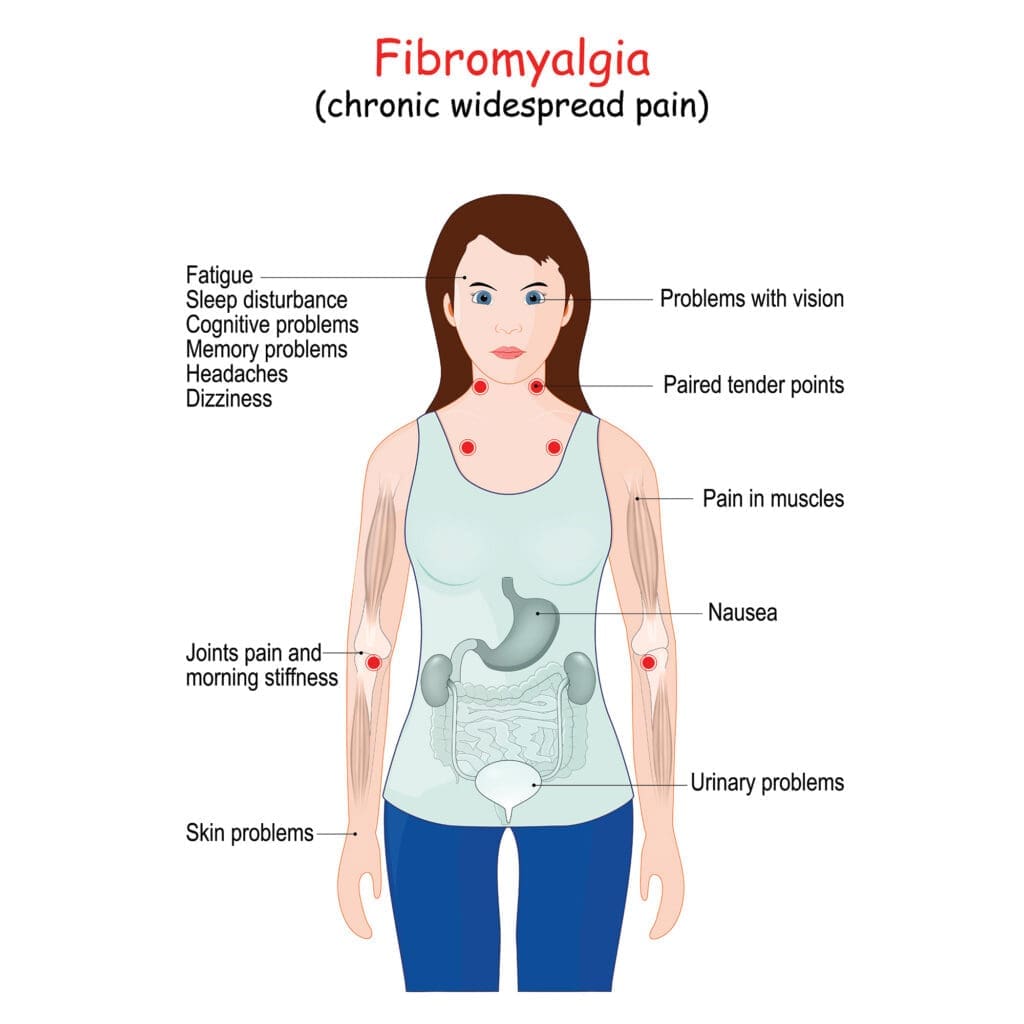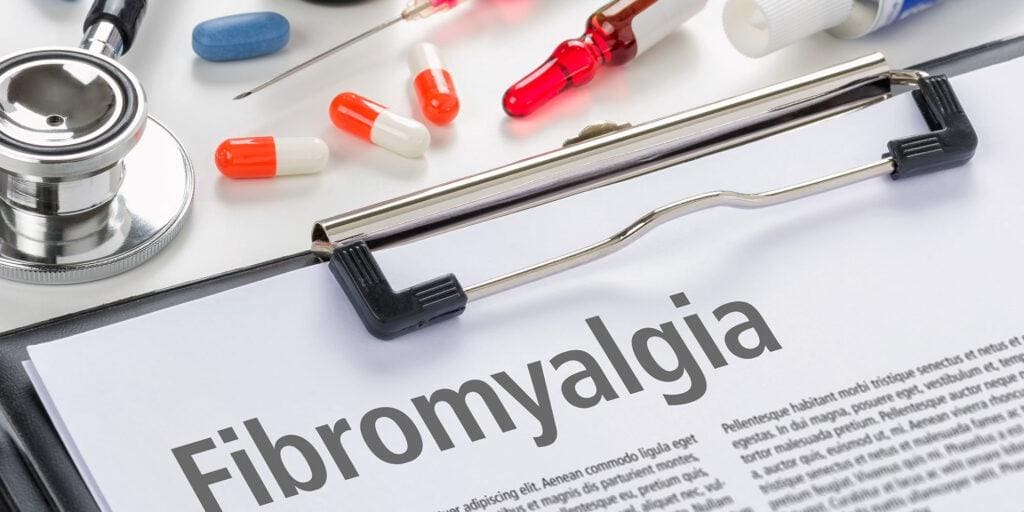Fibromyalgia is a chronic condition that can result in pain throughout the body, along with other debilitating symptoms. An estimated number of 4 million adults in the United States are diagnosed with fibromyalgia. However, there is still so much left unknown about the types of fibromyalgia pain.
What does fibromyalgia feel like? What are the different types of fibromyalgia pain? And what might life look like for a fibromyalgia patient? Below, we go further into these questions on the types of fibromyalgia pain, including the wide range of symptoms as well as treatment options, so that you can make the most informed decisions about your care.
What Are the Symptoms of Fibromyalgia?
 Fibromyalgia is a unique condition in that medical professionals don’t quite know exactly what causes the pain. The experts who study this disorder believe that fibromyalgia patients might be more sensitive to pain. This could be a result of overactive pain receptors throughout the body.
Fibromyalgia is a unique condition in that medical professionals don’t quite know exactly what causes the pain. The experts who study this disorder believe that fibromyalgia patients might be more sensitive to pain. This could be a result of overactive pain receptors throughout the body.
While a blood test to detect fibromyalgia is in the works, it’s not accessible to all patients because of availability and cost. Furthermore, it’s not a perfect science. Instead, most doctors who specialize in fibro, like a rheumatologist, usually diagnose based on the symptoms.
The main symptom of fibromyalgia would be having pain in multiple parts of the body. All-over body pain is common for people with fibromyalgia, but the criteria for diagnosis would be experiencing persistent, severe pain in 3 to 6 parts of the body or having chronic, mild pain in at least 7 different bodily areas.
There are other very prevalent symptoms of fibromyalgia to consider when being evaluated for a diagnosis as well. These include:
- Difficulties sleeping
- Restless leg syndrome
- Brain fog
- Mental health distress
The different types of fibromyalgia pain can influence all of these symptoms. Not only does pain make it challenging to get comfortable enough to sleep, but it can impact one’s ability to think clearly. Additionally, chronic pain in general can have a serious impact on mental wellness. Anxiety and depression are common co-occurring disorders for people with fibromyalgia pain. After all, not having the right care team or treatment plan can leave people with fibromyalgia feeling alone—despite how prevalent this condition is throughout the country.
What’s interesting is that in order to get a diagnosis of fibromyalgia, other medical conditions usually need to be ruled out first. Many different types of arthritis, for example, are commonly misdiagnosed as fibro and vice versa—but arthritis, lupus, and other chronic disorders can actually be co-occurring with fibromyalgia as well. This plus the wide range of signs and symptoms that people experience can make fibromyalgia challenging to diagnose.
This is why it’s important to understand the types of fibromyalgia pain. Most importantly, keeping track of what your body is telling you through these symptoms is essential. With a better understanding of your own symptoms, it makes getting a diagnosis and subsequent treatment a little easier.
What Are the Types of Fibromyalgia Pain?
Now that we know about some of the signs and symptoms of fibromyalgia, we can look closer at the different types of fibromyalgia pain. Note, of course, that every fibromyalgia patient has their own experiences of pain. Though this list goes through the most common types of fibromyalgia pain, it is by no means extensive when it comes to the full impact of this chronic condition.
That said, people with fibromyalgia pain tend to have some of the following:
- Body aches—Part of the widespread pain that happens as a result of fibro manifests as aching. Often, fibromyalgia patients feel this in their joints, with some people comparing it to arthritis aches or polymyalgia.
- Numbness and tingling—This sensation happens frequently in the arms, legs, and faces of patients with fibromyalgia. Numbness and tingling can be a sign of other serious health concerns, though, so it’s essential that you keep track of any new or worsening symptoms to report back to your doctor.
- Tender points—Assessing tender points throughout the body used to be one of the ways that fibromyalgia was diagnosed, though experts now know that there’s so much more to consider when it comes to diagnosing this condition. Tender points are, as the name suggests, painful spots in specific parts of the body, such as the base of the neck, back of the shoulders, or near the knees, elbows, hips, and so on. When pressed, these tender points cause pain and discomfort in that exact spot.
- Stiffness—Fibromyalgia can make it challenging to move your body in the ways you are used to. As a result, fibromyalgia patients might feel stiffness in their joints, especially upon waking up in the morning or after staying in one position for a certain length of time.
- Headaches—Chronic pain and headaches have always co-existed. With fibromyalgia, these headaches are often exacerbated by the all-over body pain. Moreover, fibromyalgia headaches can quickly turn into full-blown migraines, which come with other symptoms such as nausea, vomiting, light sensitivity, etc.
- Stomach pain—Finally, some people with fibromyalgia are surprised to learn that their stomach pains are related to this chronic condition. In fact, the majority of people living with fibromyalgia deal with constant gastrointestinal symptoms. Studies show that people with fibromyalgia are also likely to have irritable bowel syndrome (IBS), food sensitivities, and other types of stomach pain.
Are There Different Treatments for Fibromyalgia Pain?
 Going through this list of the different types of fibromyalgia pain can be overwhelming, especially if you’ve been looking for answers on how to treat these often debilitating symptoms. Depending on the symptoms you have, there are a variety of ways to approach fibromyalgia treatment. These include:
Going through this list of the different types of fibromyalgia pain can be overwhelming, especially if you’ve been looking for answers on how to treat these often debilitating symptoms. Depending on the symptoms you have, there are a variety of ways to approach fibromyalgia treatment. These include:
- Medications to reduce pain
- Physical therapy
- Yoga and other gentle movement
- Medical massage
- Special diet
- Alternating ice and heat
- Using mobility aids
- New digital fibromyalgia treatment
Sometimes, even these treatments are not enough to combat the types of fibromyalgia pain, though. In the instances when the pain becomes too much to cope with, other approaches could be beneficial, such as:
- Finding distractions from pain (playing a game, listening to music, chatting with friends, etc.)
- Meditation or mindfulness
- Counseling
- Joining chronic pain advocacy groups
For many patients, finding the right combination of all of these treatments is the key to managing the types of fibromyalgia pain. It’s a careful balance between maintaining functionality, reducing pain, and still having the best quality of life every fibromyalgia patient wants to have.
Ultimately, the types of fibromyalgia pain patients experience and the full impact that it has on their everyday lives depends entirely on the person. However, looking deeper into the types of fibromyalgia pain often helps people to see that they are not alone. This emphasizes the importance of sharing your own experiences so that medical professionals and other survivors of this chronic condition can continue to learn more about the ever-evolving types of fibromyalgia pain.
Do You Suffer From Fibromyalgia Pain?
Let us know in the comments below!
What topics related to Fibromyalgia should we cover next?
Email us your ideas at info@painresource.com!
Are you or someone you know living with Fibromyalgia Pain? Are you looking for the right Fibromyalgia group to get involved with?


Wow, this is really helpful information! I’m definitely sending this to my mom– she has been really wondering if she has Fibromyalgia and I think this would be a great read for her. Great work!